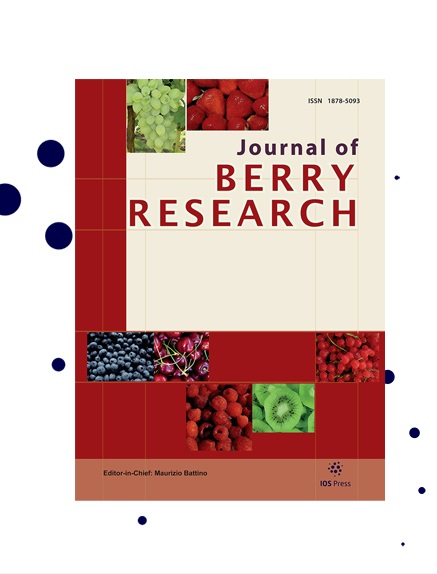棕榈花青素绿色合成及纳米金的表征
IF 1.4
4区 农林科学
Q3 PLANT SCIENCES
引用次数: 0
摘要
背景:近几十年来,以贵金属为基材的纳米颗粒绿色合成技术得到了广泛的研究。黄金的物理和光学特性,以及在植物提取物中发现的代谢物作为盖层剂,使人们能够开发出可用于人类健康替代疗法的材料。目的:研究以棕榈莓中纯化的花青素(ACNs)为还原剂和稳定剂,通过绿色合成金纳米颗粒(AuNPs)。结果:以1.6 mg: 0.6 mM (ACNs:HAuCl4)的比例获得的胶体溶液在30°C下,通过紫外可见光谱监测10 h,在540 nm处产生表面等离子体共振(SPR)信号。利用傅里叶变换红外光谱(FTIR)分析了acn与aunp之间的相互作用。扫描电子显微镜(SEM)和透射电子显微镜(TEM)发现,在30°C时平均尺寸为13 nm,以球形形貌为主,而在20°C时则出现三角形形貌。能量色散x射线能谱(EDX)和元素图显示金元素占主导地位。通过ORAC和ABTS分析抗氧化活性,发现aunp和acn之间的EC50差异高达4倍。结论:这些结果确定了acn在绿色合成AuNPs中的作用及其在不同温度下诱导各种形态的能力。本文章由计算机程序翻译,如有差异,请以英文原文为准。
Green synthesis and characterization of gold nanoparticles using anthocyanins from Rubus palmeri
BACKGROUND: The green synthesis of nanoparticles based on noble metals has been researched in the last decades. The physical and optical properties of gold, along with the metabolites found in plant extracts that work as capping agents, allow the development of materials that can be used in alternative therapies in human health. OBJECTIVE: This study reports the obtention of gold nanoparticles (AuNPs) through a green synthesis process, using purified anthocyanins (ACNs) from Rubus palmeri berries as reducing and stabilizing agents. RESULTS: The colloidal solution obtained with a ratio of 1.6 mg: 0.6 mM (ACNs:HAuCl4) was monitored through UV-Vis spectroscopy over 10 h at 30°C, producing a surface plasmon resonance (SPR) signal at 540 nm. The interaction between the ACNs and the AuNPs was analyzed through Fourier-transform infrared spectroscopy (FTIR). Scanning electron microscopy (SEM) and transmission electron microscopy (TEM) determined an average size of 13 nm with a spherical morphology predominance at 30°C, while at 20°C triangular morphologies appeared. Energy-dispersive X-ray spectroscopy (EDX) and elemental mapping showed predominance of the gold element. The antioxidant activity was analyzed by ORAC and ABTS assays, showing a variation of up to four times the EC50 between the AuNPs and the ACNs. CONCLUSION: These results determined the role of ACNs in the green synthesis of AuNPs and their capability to induce various morphologies at different temperatures.
求助全文
通过发布文献求助,成功后即可免费获取论文全文。
去求助
来源期刊

Journal of Berry Research
Biochemistry, Genetics and Molecular Biology-Biochemistry
CiteScore
3.50
自引率
11.80%
发文量
21
期刊介绍:
The main objective of the Journal of Berry Research is to improve the knowledge about quality and production of berries to benefit health of the consumers and maintain profitable production using sustainable systems. The objective will be achieved by focusing on four main areas of research and development:
From genetics to variety evaluation
Nursery production systems and plant quality control
Plant physiology, biochemistry and molecular biology, as well as cultural management
Health for the consumer: components and factors affecting berries'' nutritional value
Specifically, the journal will cover berries (strawberry, raspberry, blackberry, blueberry, cranberry currants, etc.), as well as grapes and small soft fruit in general (e.g., kiwi fruit). It will publish research results covering all areas of plant breeding, including plant genetics, genomics, functional genomics, proteomics and metabolomics, plant physiology, plant pathology and plant development, as well as results dealing with the chemistry and biochemistry of bioactive compounds contained in such fruits and their possible role in human health. Contributions detailing possible pharmacological, medical or therapeutic use or dietary significance will be welcomed in addition to studies regarding biosafety issues of genetically modified plants.
 求助内容:
求助内容: 应助结果提醒方式:
应助结果提醒方式:


